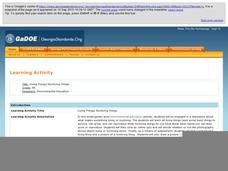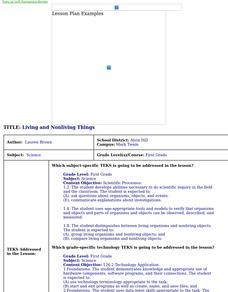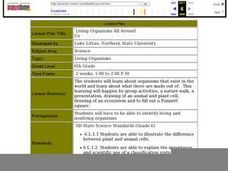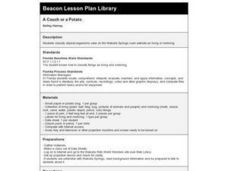Georgia Department of Education
Living Things/ Nonliving Things
How can you tell if something is living or nonliving? Introduce a set of criteria which can be used to determine which things are alive and which are not. The class discusses the basic needs of all living organisms, checks out an...
Lerner Publishing
Living or Nonliving
It's alive! Or is it? Through a series of shared readings, whole class activities, and independent exercises children explore the difference between living and non-living things, creating a pair of printable books to demonstrate their...
Curated OER
Living-Nonliving
Students determine that environments have living and nonliving parts. They discuss what makes something a living thing and something a nonliving thing. They make a chart and list characteristics of living things and nonliving things.
Curated OER
Sorting Living and Nonliving Objects
Third graders sort and classify objects. In this sorting lesson, 3rd graders sort small objects such as cereal or candy. Then, students classify and sort objects that are living or nonliving.
Curated OER
Living or Nonliving
Young scholars explore the characteristics that distinguish living things from nonliving things. By examining video and photographs, students gather evidence and develop criteria to decide if something is living or nonliving.
Curated OER
Living or Nonliving
Third graders brainstorm a list of the characteristics of living and nonliving organisms. Individually, they find four nonliving and living items and the characteristics that make them fit into one of the categories. To end the lesson,...
Curated OER
Living and Non-Living Things in the Environment
Third graders examine living and non-living things and observe a plant growing in the classroom. There are many additional resources to assist learning and extension work, they can read books, interact with PowerPoint presentations, and...
Curated OER
Terrariums: A Look at the Living and Nonliving World
Third graders examine life in a terrarium and relate it to life in a larger environment. In this terrarium lesson plan, 3rd graders examine how living and non-living things work together by examining the changes in a terrarium. They make...
Curated OER
Going on a Living and Nonliving Hunt
Students distinguish between things that are living, things that were once-living, and things that are nonliving. They graph results and create a compare and contrast Venn Diagram. They read 'Living and Nonliving' by Angela Royston.
Curated OER
Living vs. Nonliving
Students explore the characteristics that distinguish living things from nonliving things. Students examine video clips and still photographs to gather evidence and develop criteria to decide if something is living or nonliving.
Curated OER
Investigation 1 - Intro: Living & Nonliving
Third graders distinguish between living and nonliving things.
Curated OER
Living and Nonliving Things
First graders distinguish between living and nonliving objects, and compare living organisms and nonliving objects.
Curated OER
Living Organisms All Around Us
Sixth graders study organisms that exist in the world and what they are made up of. They participate in a nature walk, a presentation, a drawing of an animal and plant cell, draw a ecosystem, and fill out a Punnett square.
National Park Service
Living & Non-Living Interactions
What better way to learn about ecosystems than by getting outside and observing them first hand? Accompanying a field trip to a local park or outdoor space, this series of collaborative activities engages children in learning about the...
Curated OER
Going on a Living and Nonliving Hunt
Third graders explore various objects and organisms to begin to distinguish between things that are living, things that were once-living, and things that are nonliving.
Curated OER
Living, Non-Living Mobile
Middle schoolers are introduced to the concept of living and nonliving organisms in general and participate in a starter activity where they build their own definitions of living and nonliving organisms.They sort organisms into living...
Curated OER
Living and Nonliving Environments
In this ecosystem worksheet, students will distinguish between the abiotic factors and biotic factors shown in a diagram. Then students will correctly order the following: population, ecosystem, community, and organism.
Curated OER
A Couch or a Potato
Learners classify objects and organisms seen on the Wakulla Springs icam website as living or nonliving.
Curated OER
The Living Environment
In this living environment worksheet, students complete a crossword puzzle given 34 clues about the various species in the environment that produce, consume and decompose. Topics also include photosynthesis, respiration, glucose, organic...
Curated OER
Investigation 3 - Terrariums / Aquariums
Third graders create aquariums or terrariums to explain how creatures depend on living and nonliving things.
Curated OER
Classifying Living and Non-Living Objects
Students investigate living organisms and define the properties of a living species. In this life characteristic lesson plan, students examine plants in their class and discuss whether or not they are alive. Students create a living...
Curated OER
What is a Living Thing?
In this living things worksheet, students complete a graphic organizer by filling in statements describing the characteristics of living things.
Curated OER
It's Alive
First graders critically analyze living and nonliving objects, then develop a list of characteristics to classify objects on a science walk. They make a book to close out the lesson.
Curated OER
Parts of Ecosystems
In this ecosystem worksheet, students brainstorm and write down as many living and nonliving things found in an ecosystem. This worksheet is a graphic organizer.

























